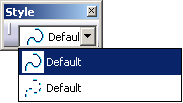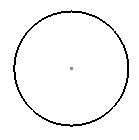-
Start creating a circle, for example. In the Style toolbar, the styles available for the type of element you are creating are displayed. In our example, two Default styles are available: one, the current style, is to be used for curves and the other one is to be used for construction curves.
-
If you want to apply the current style to the circle, you do not need to do anything. If you want to apply the other style, you can select it from the Style toolbar.
-
Click to validate and end the circle creation. The circle is created with the selected style, as defined in the standard used by the drawing. (Consequently, you may obtain a different result than the one shown here).
-
Now, start creating a radius dimension for this circle. Once again, the Style toolbar displays the styles available for radius dimensions. In our example, only one style is available, therefore it will be used by default (you don't need to select it).
-
In the Graphic Properties toolbar, select another color, red, for example.
In the Style toolbar, an asterisk appears in front of the selected style: this asterisk indicates that the style of the element you are creating has been overloaded compared to the style which is defined in the standards.
- Depending on the type of style selected (curve, dimension, etc.), only the relevant fields are available in the various properties toolbars. For example, if you select a curve style, text and dimension properties will be disabled from the associated toolbars.
- In the case of dimensions, note that if you use the generic
Dimensions
 command, all default dimension styles (i.e. length, radius, etc.) are
available in the Style toolbar. In this case, make sure that you first
select the style corresponding to the type of dimension that you are
about to create, i.e. before overloading it. Otherwise, you will be
overloading the current dimension style (which is Length by default); if
you subsequently select an element that does not match the current
dimension style, the style will change to match the selected element
(e.g. if you then select a circle, a radius dimension will be created)
and you will lose your style modifications (i.e. the style for the
selected element will not be overloaded).
command, all default dimension styles (i.e. length, radius, etc.) are
available in the Style toolbar. In this case, make sure that you first
select the style corresponding to the type of dimension that you are
about to create, i.e. before overloading it. Otherwise, you will be
overloading the current dimension style (which is Length by default); if
you subsequently select an element that does not match the current
dimension style, the style will change to match the selected element
(e.g. if you then select a circle, a radius dimension will be created)
and you will lose your style modifications (i.e. the style for the
selected element will not be overloaded).
-
At this point, you have two options:
- You can either revert to the standard-defined values (i.e. reset the toolbar properties to their original values) by re-selecting this style from the Style toolbar, and then clicking to validate and end the dimension creation. The asterisk will disappear.
- Or you can apply the modified style by clicking to validate and end
the dimension creation. For the purpose of this scenario, do this.
The dimension is created with the selected style, as defined in the standard and overloaded by the properties you changed. (Once again, as the result depends on the parameters defined in your standard, you may obtain a different result than the one shown here.)

![]()




